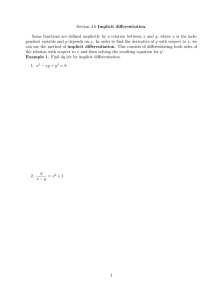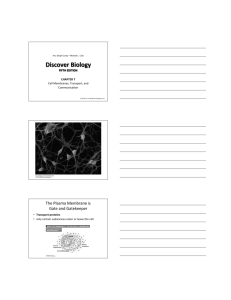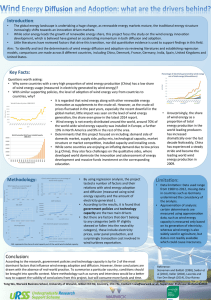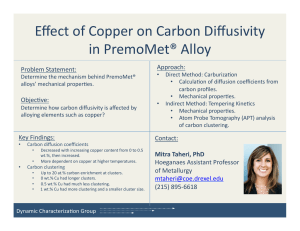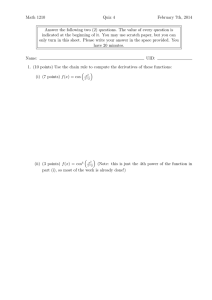Document 13426253
advertisement
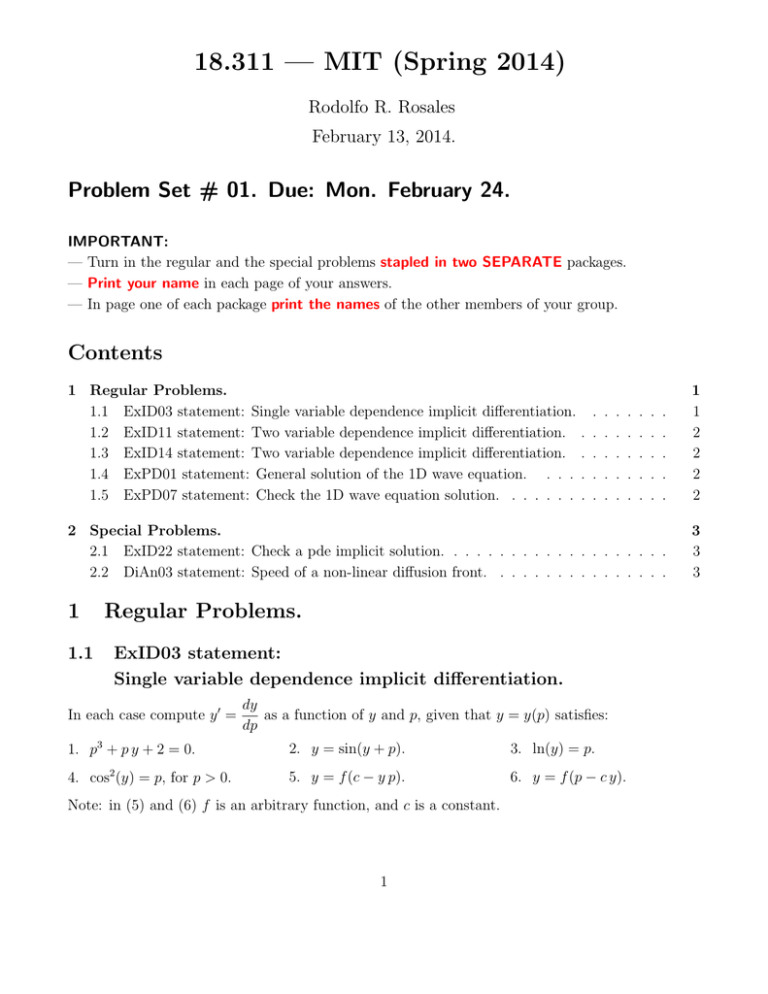
18.311 — MIT (Spring 2014) Rodolfo R. Rosales February 13, 2014. Problem Set # 01. Due: Mon. February 24. IMPORTANT: — Turn in the regular and the special problems stapled in two SEPARATE packages. — Print your name in each page of your answers. — In page one of each package print the names of the other members of your group. Contents 1 Regular Problems. 1.1 ExID03 statement: Single variable dependence implicit differentiation. 1.2 ExID11 statement: Two variable dependence implicit differentiation. 1.3 ExID14 statement: Two variable dependence implicit differentiation. 1.4 ExPD01 statement: General solution of the 1D wave equation. . . . 1.5 ExPD07 statement: Check the 1D wave equation solution. . . . . . . . . . . . 1 1 2 2 2 2 2 Special Problems. 2.1 ExID22 statement: Check a pde implicit solution. . . . . . . . . . . . . . . . . . . . 2.2 DiAn03 statement: Speed of a non-linear diffusion front. . . . . . . . . . . . . . . . 3 3 3 1 . . . . . . . . . . . . . . . . . . . Regular Problems. 1.1 ExID03 statement: Single variable dependence implicit differentiation. In each case compute y ' = dy as a function of y and p, given that y = y(p) satisfies: dp 1. p3 + p y + 2 = 0. 2. y = sin(y + p). 3. ln(y) = p. 4. cos2 (y) = p, for p > 0. 5. y = f (c − y p). 6. y = f (p − c y). Note: in (5) and (6) f is an arbitrary function, and c is a constant. 1 . . . . . . . . . . . . . . . 1.2 ExID11 statement: Two variable dependence implicit differentiation. In each case compute ux = ∂u ∂u (as functions of u, x, and y), given that u = u(x, y) and uy = ∂x ∂y satisfies: 1. x3 y + 2 x u + y u3 = 0. 2. y = f (y + u x). 3. ln(1 + y) = u ex u . Note: In (2) f is an arbitrary function of a single variable, f = f (ζ). Assume that f ' = 0. 1.3 ExID14 statement: Two variable dependence implicit differentiation. In each case compute ux = ∂u ∂u and up = (as functions of u, x, and p), given that u = u(x, p) ∂x ∂p satisfies: 2 1. cos(p2 u) = p e−x . 2. p = cos(x + u). 3. u = p f (x + u). Note: In (3) f is an arbitrary function of a single variable, f = f (ζ). 1.4 ExPD01 statement: General solution of the 1D wave equation. Consider the wave equation for u = u(x, t), where c > 0 is a constant, utt − c2 uxx = 0. (1.1) Introduce the new independent variables η = x − c t, and ξ = x + c t. Change variables to write the equation for u as a function of these new variables: u = u(η, ξ). Using this transformed form of the equation, integrate it twice to show that it must be u = f (η) + g(ξ), (1.2) for some arbitrary functions f and g. This shows that any solution of the wave equation (1.1) must have the form u = f (x − c t) + g(x + c t). 1.5 ExPD07 statement: Check the 1D wave equation solution. By direct substitution, show that u = f (x − c t) + g(x + c t) — where f and g are arbitrary func­ tions, and c is a constant — is a solution to the 1D wave equation: 2 ∂2 2 ∂ u = c u. ∂x2 ∂t2 2 2 Special Problems. 2.1 ExID22 statement: Check a pde implicit solution. By direct substitution, show that yields a solution to the equation: y = u2 + f e−x u (2.3) ux + 2 u2 uy = u. (2.4) Here f is an arbitrary function. Note that: 1. Equation (2.3) defines u implicitly. You have to find ux and uy by implicit differentiation. 2. Equation (2.4) is nonlinear. 2.2 DiAn03 statement: Speed of a non-linear diffusion front. Consider some substance diffusing in an isotropic1 medium at rest. Then, as shown in the lectures, the following equation applies (2.5) Ct = div (ν C) , where 1. Fick’s law of diffusion was assumed: the substance flux due to diffusion is along the gradient of the concentration, from higher to lower concentrations. For this it is important that the medium be isotropic — else the flux diffusion may occur along directions that depend both on the gradient of the concentration, as well as special directions in the media. 2. C = C(ix, t) is the substance concentration (mass per volume) — e.g.: grams per liter. 3. ν > 0 is the diffusion coefficient. 4. C is the gradient of the concentration, and div denotes the divergence of a vector field. When ν is a constant (2.5) reduces to the linear diffusion equation Ct = ν Δ C, (2.6) where Δ is the Laplacian operator, Δ = ∂x2 + ∂y2 + ∂z2 . However, there are situations where the diffusion coefficient is not constant, and depends (for example) on the concentration, or its gradient. Here we will consider the particular case where ν ∝ ( C)2 and the medium is homogeneous.2 Then (2.5) reduces to Ct = µ div ( 1 2 C)2 C , Isotropic means that the properties of the medium are invariant under rotation. Homogeneous means that the properties of the medium are the same everywhere. 3 (2.7) where µ > 0 is a constant. Under conditions where (2.7) applies, imagine that at t = 0 there is a very tiny blob of substance somewhere in the media. Then, due to the diffusion, the size of the blob will increase with time — with a sharp edge between the region where C > 0, and the region where there is no substance. Note: In this the behavior of (2.7) differs from that of (2.6). In the case of the linear diffusion equation, the blob’s edge ceases to be sharp for t > 0, even if the initial blob has a sharp edge. Problem Tasks. What you are expected to do. Let M be the total mass in the blob, and make the approximation that, at time t = 0 the blob is just a point — i.e.: all the substance’s mass is concentrated in a blob so tiny that you can think of it as a point. Then perform the tasks below, using qualitative (but precise) and physical arguments only — do not solve the equation. q1. What dimensions does µ have? q2. Argue that the shape of the blob is a sphere for t > 0. q3. Find a formula for the radius of the blob R = R(t) as a function of time — namely: a formula of the form R = α f (t), where α is a dimension-less constant (a number), and f (t) is some function of time. You will not able to calculate α without solving the p.d.e. (2.7), which you are not expected to do. But you should be able to fully determine the function f (t). Assume now that R(t) = 5 mm when t = 3.75 sec. q4. What value does R take for t = 3840 sec = 64 min? q5. For what value of t is R = 5 cm? q6. Would your answers change if the nonlinear diffusion occurred in the plane, instead of in 3-D? In particular, what are the answers to q1 and q3 in 2-D? Hint. The formula giving the radius as a function of time must involve physical constants that allow it to transform time into length. These physical constants must be, in turn, result from the physical constants in the problem, and only them — e.g.: if you write a formula that involves the speed of light in it, something went wrong with your reasoning! THE END. 4 MIT OpenCourseWare http://ocw.mit.edu 18.311 Principles of Applied Mathematics Spring 2014 For information about citing these materials or our Terms of Use, visit: http://ocw.mit.edu/terms.
